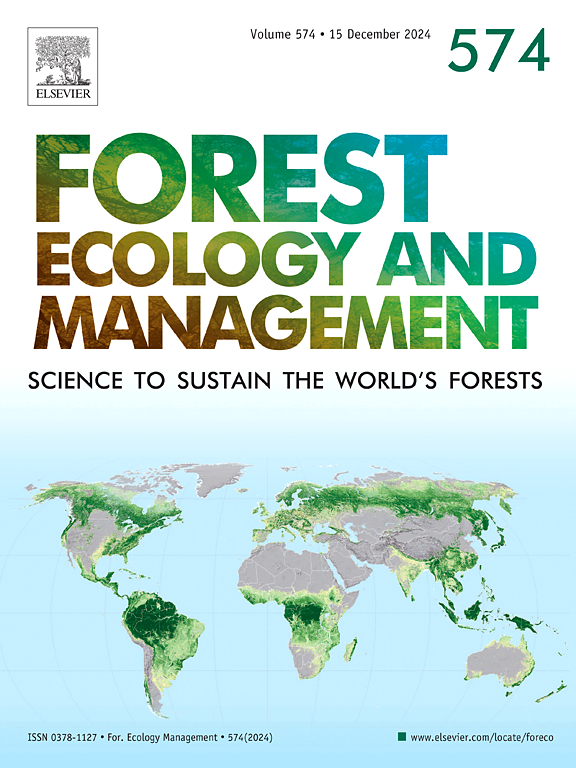Forest transformation increases soil N2O fluxes in an unmanaged Moso bamboo forest
IF 3.7
2区 农林科学
Q1 FORESTRY
引用次数: 0
Abstract
Moso bamboo forests have a high capacity for carbon sequestration and are associated with greenhouse gas emissions, but are facing abandonment due to rising labor costs and falling prices of bamboo products. Due to lower carbon fixation and ecosystem degradation of abandoned bamboo forest, transformation (thinning and replanting with tree species) has recently been used to address the issue but its effect on soil N2O fluxes is unknown. In this study, a 25-month field experiment was conducted with four management treatments (light, moderate and heavy strip transformation and abandonment management), using intensive management as a control, to investigate the effects of abandonment and its transformation on soil N2O fluxes in shallow soils of an abandoned Moso bamboo forest. The results revealed that the highest N2O emissions occurred in the intensive management control, while the lowest values were observed under the abandonment management. Furthermore, compared with the control, forest transformation with heavy, moderate and light intensities and abandonment management lowered annual cumulative soil N2O emissions by 7 %, 12 %, 14 %, and 20 %, respectively, in the first year, and by 6 %, 14 %, 17 %, and 22 %, respectively, in the second year. Regardless of the treatment, soil N2O emissions were correlated positively with soil temperature, and the concentrations of NO3--N, NH4+-N, microbial biomass C and N, and water-soluble organic C and N (P < 0.05), but negatively with soil water-filled porosity (P < 0.01). The increased N2O emissions in the forest transformation treatments had mainly resulted from the elevated soil temperature and increased concentrations of labile C and N. The study suggests that the light strip transformation, due to its lower N2O emissions during the first two years of the transformation, is a favorable practice for managing abandoned Moso bamboo forests.
森林改造增加了无人管理的毛竹林的土壤一氧化二氮通量
毛竹林固碳能力强,与温室气体排放有关,但由于劳动力成本上升和竹制品价格下降,毛竹林正面临被遗弃的问题。由于废弃竹林的碳固定能力较低且生态系统退化,最近有人采用改造(疏伐并重新种植树种)的方法来解决这一问题,但其对土壤一氧化二氮通量的影响尚不清楚。本研究进行了为期 25 个月的田间试验,以强化管理为对照,采用四种管理处理(轻度、中度和重度带状改造和废弃管理),研究废弃及其改造对废弃毛竹林浅层土壤 N2O 通量的影响。结果表明,集约经营对照组的 N2O 排放量最高,而遗弃经营对照组的数值最低。此外,与对照组相比,重度、中度和轻度森林改造以及废弃管理在第一年分别降低了 7%、12%、14% 和 20%,在第二年分别降低了 6%、14%、17% 和 22%。无论采用哪种处理,土壤 N2O 排放量都与土壤温度、NO3--N、NH4+-N、微生物生物量 C 和 N 以及水溶性有机 C 和 N 的浓度呈正相关(P < 0.05),但与土壤水分填充孔隙度呈负相关(P < 0.01)。该研究表明,轻型带状改造由于在改造的头两年N2O排放量较低,是管理废弃毛竹林的一种有利方法。
本文章由计算机程序翻译,如有差异,请以英文原文为准。
求助全文
约1分钟内获得全文
求助全文
来源期刊

Forest Ecology and Management
农林科学-林学
CiteScore
7.50
自引率
10.80%
发文量
665
审稿时长
39 days
期刊介绍:
Forest Ecology and Management publishes scientific articles linking forest ecology with forest management, focusing on the application of biological, ecological and social knowledge to the management and conservation of plantations and natural forests. The scope of the journal includes all forest ecosystems of the world.
A peer-review process ensures the quality and international interest of the manuscripts accepted for publication. The journal encourages communication between scientists in disparate fields who share a common interest in ecology and forest management, bridging the gap between research workers and forest managers.
We encourage submission of papers that will have the strongest interest and value to the Journal''s international readership. Some key features of papers with strong interest include:
1. Clear connections between the ecology and management of forests;
2. Novel ideas or approaches to important challenges in forest ecology and management;
3. Studies that address a population of interest beyond the scale of single research sites, Three key points in the design of forest experiments, Forest Ecology and Management 255 (2008) 2022-2023);
4. Review Articles on timely, important topics. Authors are welcome to contact one of the editors to discuss the suitability of a potential review manuscript.
The Journal encourages proposals for special issues examining important areas of forest ecology and management. Potential guest editors should contact any of the Editors to begin discussions about topics, potential papers, and other details.
 求助内容:
求助内容: 应助结果提醒方式:
应助结果提醒方式:


